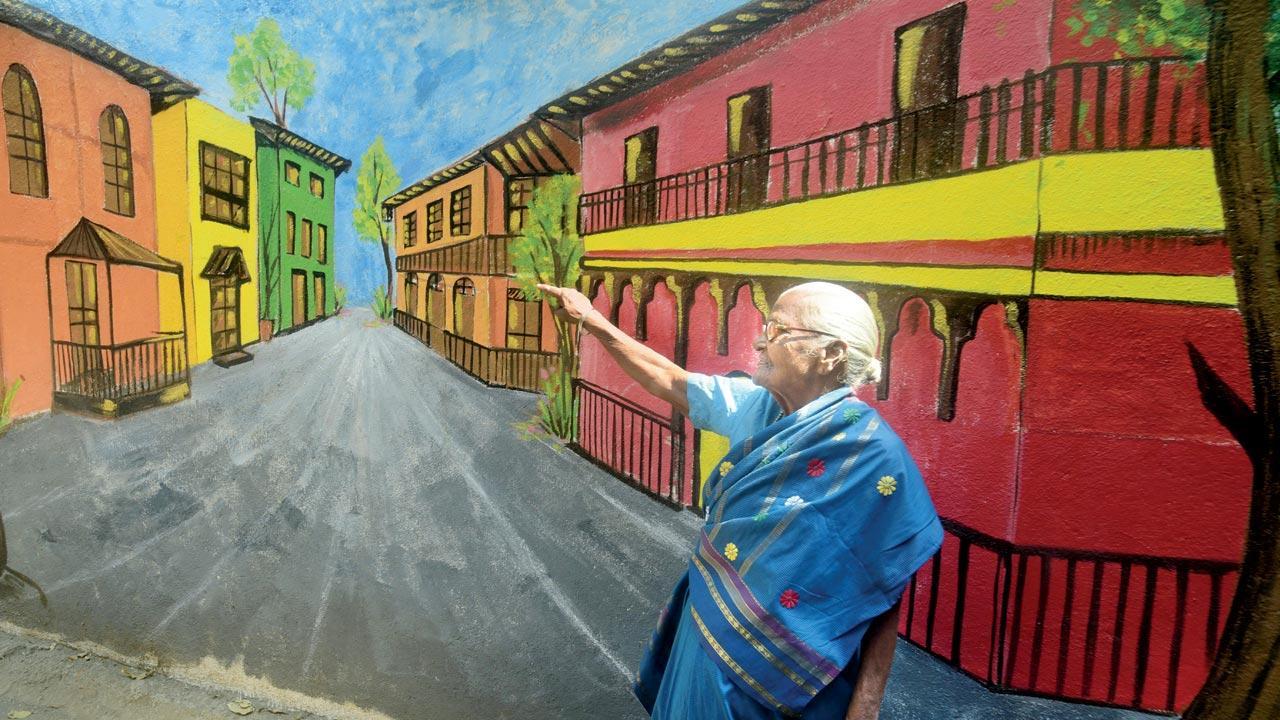A public art initiative by East Indian residents of Marol Gaothan’s Oleria has given the locality a vibrant makeover that highlights their centuries-old traditions

Victoria Prasad, a nonagenarian and one of the oldest residents of the gaothan, sports a lugra. Pics/Atul Kamble
The GPS on your phone might not be of much help once you veer off the main road to find Mumbai 59, in Marol Gaothan. If the many Pereira, D’Souza or Pimenta name plates can’t guide you, ask around for “the wall painting village”, and you’ll be led to Oleria, one of the 14 zones comprising the gaothan. Narrow, winding cobbled streets dotted with crosses dating back to the 1500s, quaint gable-roofed houses that once sported Mangalore tiles and occasional patches of green inside cemented courtyards — it’s a miracle how Oleria has managed to retain its old-world charm despite the visible onslaught of urbanisation. And its East Indian residents — around 155 families — have come together to preserve their heritage through the Gaothan Art 59 Project.
The art project has propelled a complete makeover of the tiny neighbourhood, with residents tying up with a gang of grafitti artists who go by Wicked Broz to paint the walls spanning an approximately 700-m stretch. Brian Pereira, a 62-year-old resident, shares that the initiative kicked off in January, after some locals including him decided to give their walls a facelift. “More residents got interested, and we got together and thought, ‘Why not paint the walls with the theme of our community’s traditions?’ That way, the youth will get to see our customs, and the place will flaunt a clean look,” he explains. Omkar Dhareshwar, co-founder, Wicked Broz, tells us the idea was to revive the community’s pride in its past: “Over two weeks, 14 of us painted the walls along with residents. It was a lot of fun, with the senior citizens and youth joining in to recreate the sights and sounds of the gaothan from 100 to 200 years ago.”
Flavian Nunes, Aaron Nunes, Munazza Mulla, Fredicia Pereira, Aulac and Derrick Pereira
The result is boundary walls depicting the community’s traditions, and offering a glimpse of an era gone by. For instance, one wall depicts umbra cha paani, the elaborate wedding rituals that the East Indians undertake. Another bears the colourful border of the lugra, the traditional garment worn by women, while others portray farmers working the paddy fields, masalas being pounded and women going fishing. Flora and fauna from the Aarey Colony also find space on the walls. “Our ancestors were closely connected with nature. They had their own paddy fields, wells and a variety of trees, almost all of which is now lost to urbanisation,” Brian laments.
The art project is, then, also a means to remind the authorities and a gnawing builders’ lobby that Marol Gaothan is not a slum, the residents tell us. “This isn’t a slum; we are the original inhabitants of Marol and the gaothan has a rich history,” Brian asserts.
A woman and cat in front of a mural
Sachin Pereira, a chef and a social service worker who resides in a 150-year-old house that’s now been redeveloped in Oleria, reveals that some of the inhabitants of Marol Gaothan were among the 500 people who were baptised at the church of Condita, in SEEPZ, during the feast of St John the Baptist in 1579. “The major portion of this church is still standing tall. Due to the epidemic, Fr Jose Paes, the then Vicar of Condita, built a new church in the village of Marol in 1840, now called St John the Evangelist Church, and transferred the parish here,” he shares about the gaothan’s origins.
What started as an art project has now prompted the community to take a closer look at its history. Sachin says that residents of surrounding zones are also approaching them to replicate the initiative. “We hosted Pancake Tuesday [the day before Ash Wednesday — when the period of Lent begins], and also plan to start heritage walks in the area, that will be wrapped up with a typical East Indian meal,” he claims, adding that they want to put Marol Gaothan on the map.
Log on to Gaothan ART 59 on Facebook
 Subscribe today by clicking the link and stay updated with the latest news!" Click here!
Subscribe today by clicking the link and stay updated with the latest news!" Click here!









